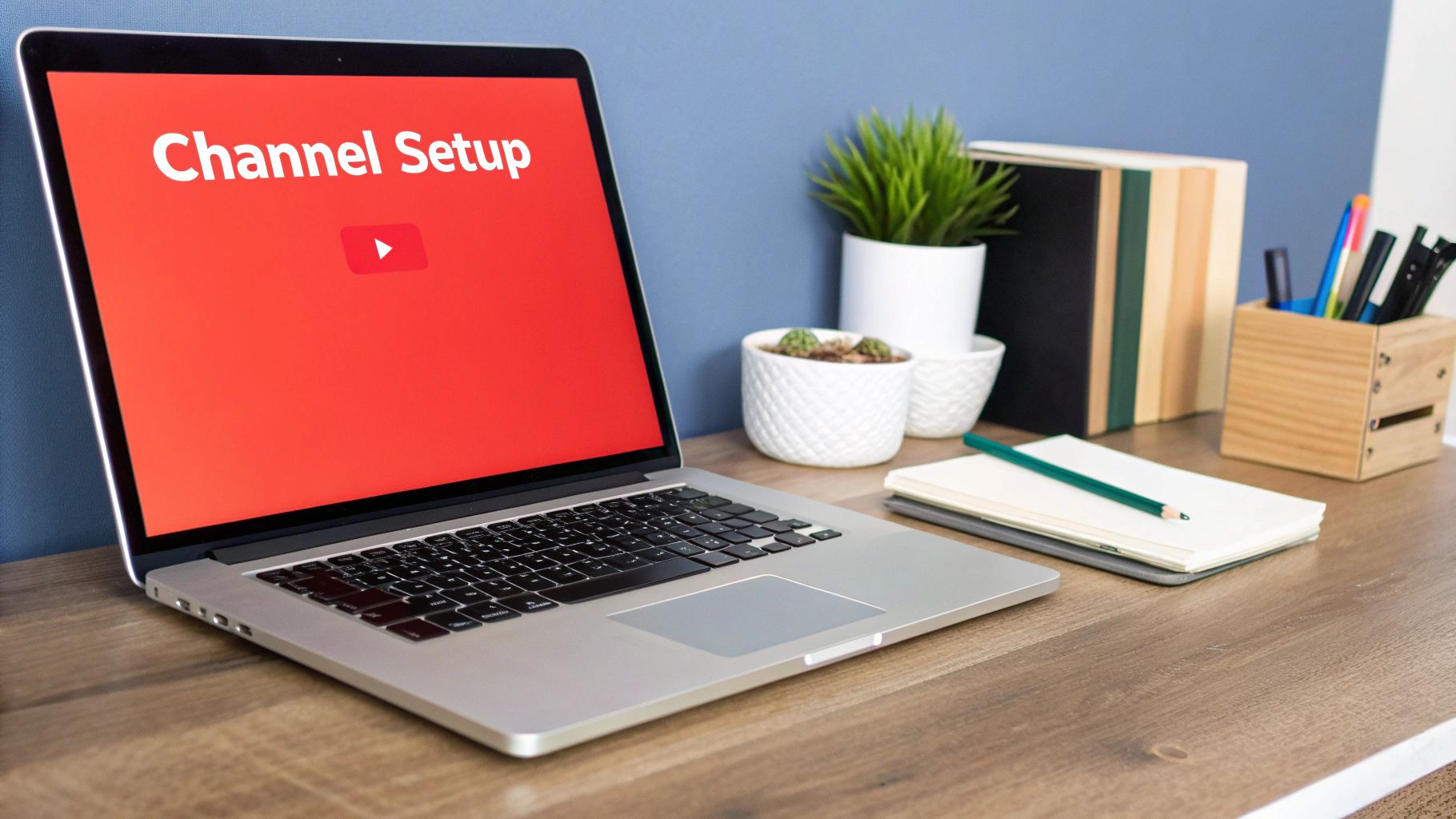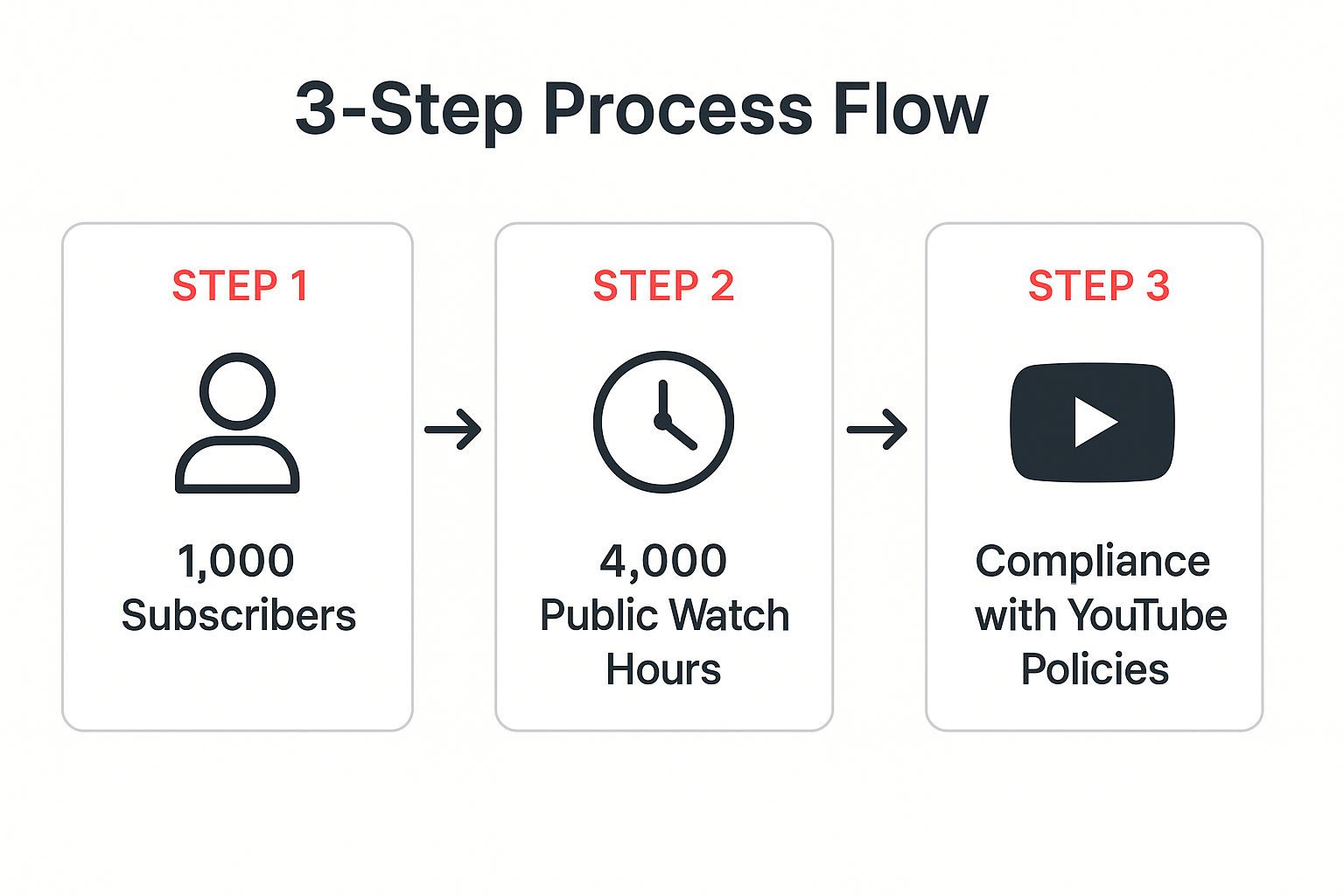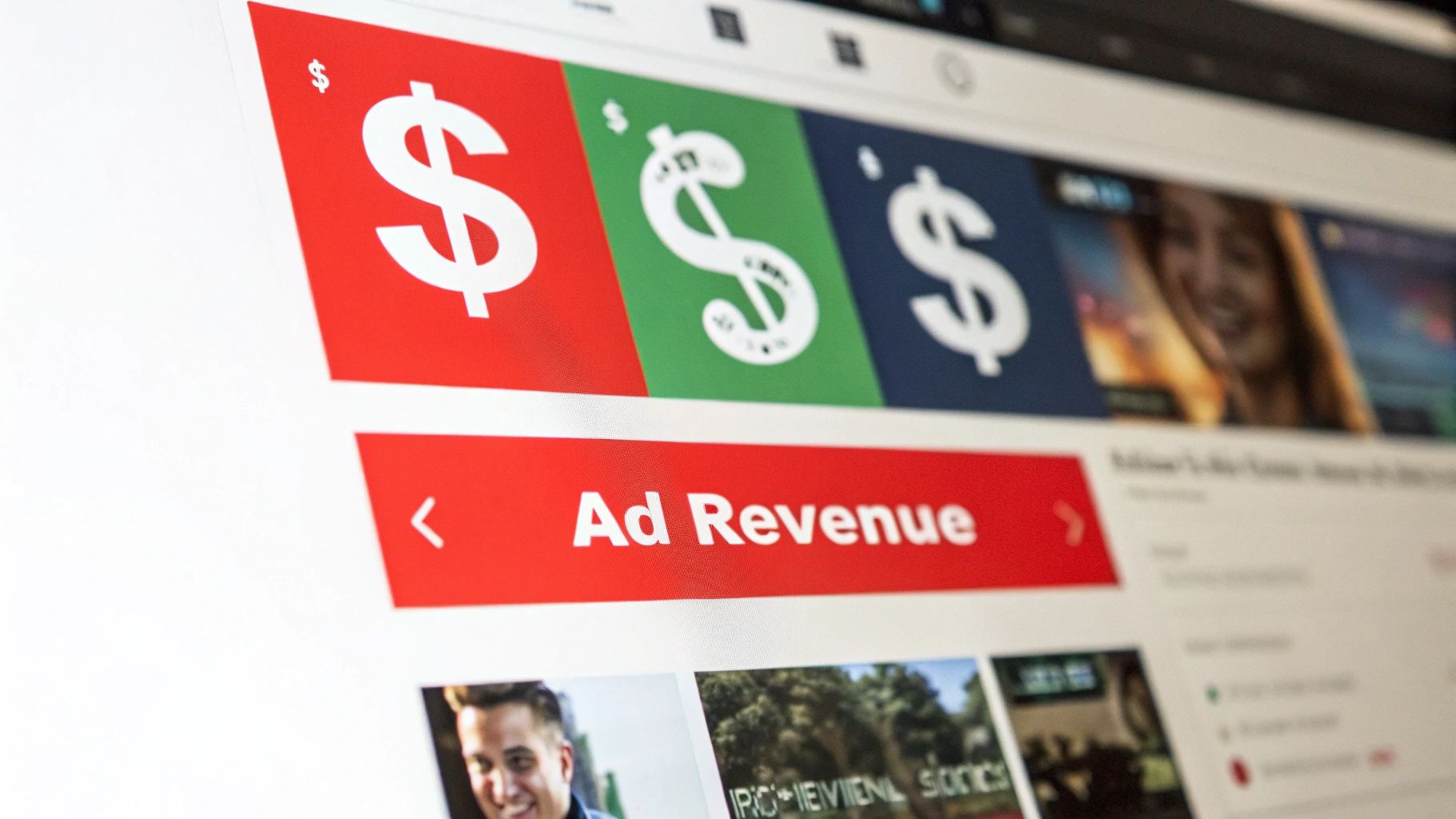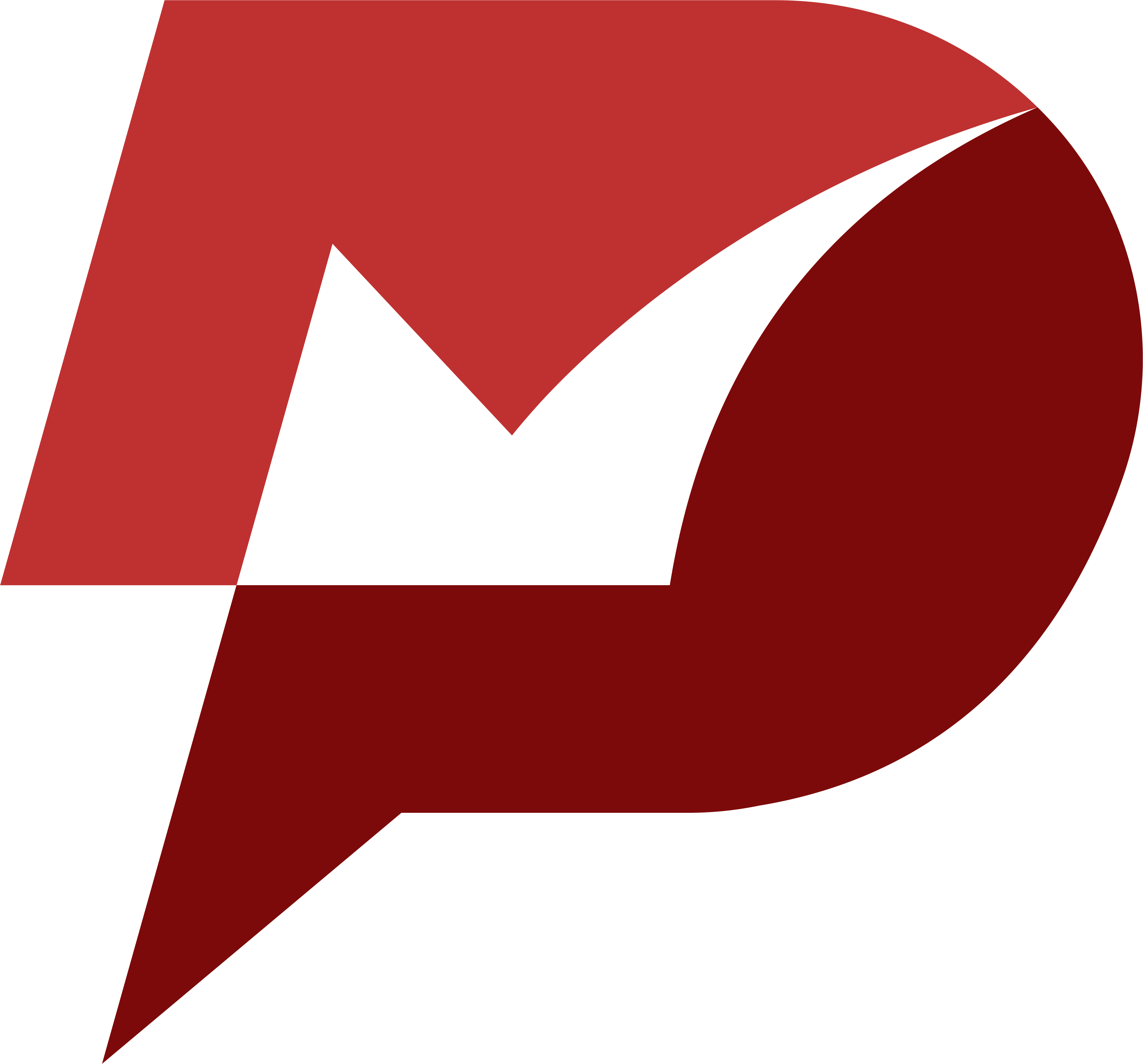So, you want to turn your passion for creating videos into a real income stream? The first major milestone on that journey is getting into the YouTube Partner Program (YPP). This is your official ticket to earning money from ads on your videos. But getting there isn't just about uploading content; it's about proving you can build and hold an audience.
Your First Steps to the YouTube Partner Program

Think of the YPP as the starting line for serious YouTube channel monetization. Reaching it means you've successfully passed YouTube's initial test and built something real. The core requirements might seem simple, but hitting them takes dedication and a smart strategy.
To get into the program and start earning with AdSense, you need to hit two key numbers: 1,000 subscribers and 4,000 hours of public watch time within the last 12 months.
At first glance, those numbers can look intimidating. I get it. But they exist for a good reason—they show advertisers that your channel has a proven track record of keeping viewers engaged. That's exactly what makes them want to run ads on your content.
Breaking Down the Core Requirements
Let's look past the numbers and talk about what it really takes to get there. Hitting these goals isn't about luck or a single viral video. It's about consistency.
- 1,000 Subscribers: This is your community. It’s a clear signal that people like what you do enough to want more of it. It’s your tribe.
- 4,000 Watch Hours: This one is often the bigger mountain to climb. Watch time measures how long people actually spend watching your videos, and it's the ultimate indicator of engagement. A channel with lots of views on 1-minute Shorts will have way less watch time than a channel with fewer views on 15-minute deep dives.
Subscribers are your loyal fans. Watch time is the proof that you can hold their attention.
From my experience, the real grind for new creators isn't getting subscribers; it's stacking up those watch hours. Your main goal should be making videos people want to finish, not just click on. High audience retention is the secret weapon for hitting that 4,000-hour mark.
For a complete breakdown of all the rules, check out our detailed guide on the current YouTube monetization requirements.
Content Strategies That Boost Watch Time
Some video styles are just better at racking up watch hours. If you're serious about getting into the YPP, leaning into these formats is a smart move.
Tutorials and how-to guides are goldmines for watch time. If you're teaching someone a skill—like how to edit a video or perfect a recipe—they have a strong incentive to watch from start to finish. Plus, these videos often rank well in search, bringing you a steady stream of new viewers over time.
Another powerful format is long-form storytelling. Think mini-documentaries, in-depth reviews, or "day in the life" vlogs that take viewers on a journey. A video titled "I Tried Dropshipping for 30 Days and Here's What Happened" is much more likely to hold attention than a quick "Top 3 Dropshipping Tips."
To make it crystal clear, here’s a quick rundown of what you’ll need to apply for the YPP.
YouTube Partner Program Eligibility at a Glance
This table breaks down the essential milestones you need to hit before you can apply for monetization.
| Requirement | Threshold | Key Action |
|---|---|---|
| Subscribers | 1,000 | Focus on creating consistent, valuable content that encourages viewers to subscribe. |
| Public Watch Hours | 4,000 in the last 12 months | Prioritize long-form content that keeps people watching and boosts audience retention. |
| AdSense Account | One linked account | Set up and link your AdSense account correctly so you can get paid. |
| Community Guidelines | Zero active strikes | Make sure all of your content is compliant, advertiser-friendly, and safe for viewers. |
Hitting these benchmarks is the first step, but remember to keep your channel in good standing by following all of YouTube's policies.
Building a Community That Cares
Finally, never forget that your subscribers are people, not just a number on a dashboard. They are the entire reason your channel can succeed, so engaging with them is non-negotiable.
Reply to comments. Ask for their opinions in your videos and community posts. Create a space where your viewers feel like they're part of something. When someone hits that subscribe button, they're investing their time in you. Honor that by delivering on your promises and building a genuinely positive community.
This approach won't just get you to 1,000 subscribers—it'll build a loyal audience that will stick with you long after you've started monetizing.
Setting Up Monetization and Navigating AdSense
So you got the email. You're in! After all the hard work, YouTube has officially welcomed you into the Partner Program. Now it's time to actually make some money. This is where YouTube channel monetization gets real, and it all funnels through Google AdSense.
Think of AdSense as your channel's business office. It's the system Google uses to collect money from advertisers and, more importantly, to send it your way. If you don't already have an AdSense account, don't worry—YouTube walks you through creating one during the application process. If you do, you just need to connect it to your channel.
Take your time with this part. You’ll have to enter your payment address and tax information, and you want to get it right. I've seen creators get their payments stuck for months because of a simple typo in their address. Double-check everything.
The AdSense Verification Journey
Once your AdSense account is linked, Google needs to make sure you're a real person at a real address. This is a two-step verification process that can feel a bit old-school, but it’s a non-negotiable security step.
First, you’ll handle identity verification. This is pretty simple: you just upload a photo of a government-issued ID, like a driver's license. It usually only takes a few days to get approved.
Next up is address verification. This one trips people up. As soon as your channel earns its first $10 or so, Google will physically mail you a letter. Yes, snail mail. Inside is a Personal Identification Number, or PIN.
Heads up: This letter looks a lot like junk mail. Do not throw it away! It's the key to unlocking your earnings. You have to log into AdSense and enter that PIN to complete your verification, or Google will hold your payments indefinitely.
This whole process is the final step after a long journey of hitting your watch time and subscriber goals.

As you can see, getting here means you’ve already cleared several major hurdles. Now you just have to set up the cash flow.
Turning On Ads and Choosing Your Formats
With the boring verification stuff out of the way, you can finally turn on the ads. Just head over to YouTube Studio, click on the "Earn" tab, and let's get started.
You have a couple of options here. You can do a bulk update to monetize all of your existing videos at once, or you can go through them one by one. I’d recommend setting a default to automatically monetize all future uploads—it's one less thing to think about when you publish.
When you enable monetization, you get to pick the ad types. This is a balance between making money and not annoying your viewers into leaving.
Here's what you'll be working with:
- Skippable in-stream ads: The classic pre-roll or mid-roll ads that viewers can skip after 5 seconds. This is your bread and butter.
- Non-skippable in-stream ads: Shorter ads, usually 15-20 seconds, that viewers have to watch all the way through.
- Bumper ads: Super quick, 6-second non-skippable ads.
- Overlay ads: The small banner ads that pop up on the bottom of the video player on desktop.
Now, for any video that’s longer than eight minutes, you unlock the most valuable tool: mid-roll ads. You can let YouTube place these automatically or, and I highly recommend this, you can place them manually.
A Practical Approach to Mid-Roll Ads
Placing mid-rolls yourself gives you total control over the viewing experience. Let YouTube do it, and you might get an ad cutting you off mid-sentence, which is a surefire way to kill your audience retention.
My personal strategy is to find the natural pauses in my videos. For example, if I'm reviewing a new piece of tech, I'll finish a whole section on its design, and then I’ll place the ad break right before I transition to talking about performance. It feels more like a natural commercial break on TV and less like a rude interruption.
Getting your YouTube channel monetization set up correctly from day one is critical. If you can get through the AdSense verification and learn to place your ads thoughtfully, you'll be in a fantastic position to turn your channel into a genuine source of income.
How to Maximize Your YouTube Ad Revenue

So, you’ve made it into the YouTube Partner Program. Congratulations! Flipping the switch to turn on ads is easy, but making a real, sustainable income from your YouTube channel monetization is a different ballgame.
Activating ads is just the first step. The real money is in optimization. This isn’t about just getting more views; it’s about increasing the value of every single view you get. I've seen countless creators get confused when a video with 100,000 views in one niche earns a fraction of what another video with the same views makes. That massive difference comes down to a few key factors you can absolutely control.
The ad world is huge, and YouTube is right at the center of it. The platform recently pulled in $36.1 billion from advertising in a single year, which tells you just how much money brands are willing to spend to get in front of the right people. For a deeper dive into these numbers, you can check out the full report on YouTube's consistent advertising growth.
Getting to Know CPM and RPM
To really boost your earnings, you need to speak the language of monetization. The two most important terms you'll live by are CPM and RPM.
-
CPM (Cost Per Mille): This is the "cost per 1,000 impressions." It’s what advertisers pay YouTube to show their ads 1,000 times. This isn't your money—it's the advertiser's cost.
-
RPM (Revenue Per Mille): This is your "revenue per 1,000 views." This is the number that should matter most to you. It’s your estimated share of the revenue (after YouTube takes its 45% cut) for every 1,000 views your videos get.
Your entire goal is to drive that RPM number up. A higher RPM means you earn more money from the same amount of traffic. And the biggest lever you can pull to influence it is your niche.
Why Your Niche is Everything
Your content niche is, without a doubt, the single biggest factor that will determine your ad revenue. Think about it: advertisers will pay a premium to reach audiences with specific interests and, more importantly, money to spend.
Let's say you create a video titled "How to Invest Your First $1,000." You’ll attract advertisers from finance, banking, and investment firms—companies with big-ticket services. They're happy to pay top dollar to reach potential clients, so your CPM in that niche could easily be $40 or more.
Now, compare that to a funny cat video. It might go viral, but it attracts general consumer brands with much smaller ad budgets. The CPM there might only be $4. Even with the exact same view count, the finance channel will crush the cat video in earnings.
Here’s a rough breakdown of how different niches stack up:
| Niche Category | Revenue Potential | Example Topics |
|---|---|---|
| High Tier | Very High | Personal finance, real estate investing, software tutorials, e-commerce strategies |
| Mid Tier | Moderate | Tech reviews, car modifications, DIY home improvement, travel vlogs |
| Low Tier | Lower | Gaming let's plays, comedy skits, prank videos, general entertainment |
This is why choosing a profitable niche from the start is so critical for your YouTube channel monetization strategy. If you're looking for more tips on this, our guide on how to make money on YouTube with ads has some great insights.
The Untapped Power of Mid-Roll Ads
Once your videos are longer than eight minutes, you unlock one of the most powerful monetization tools available: mid-roll ads. These are ad breaks you can place during your video, not just before or after.
Whatever you do, don't let YouTube place these automatically. Its algorithm often shoves them in at the worst possible moments, killing your flow and causing viewers to leave. A drop in audience retention is a bad signal to YouTube.
The smart move is to place them manually. Watch your video and find natural breaks in the content—like after you've made a key point and are about to transition to the next. It feels less like an interruption and more like a planned commercial break. For a 10-12 minute video, starting with one or two well-placed mid-rolls is perfect. This simple tweak can often boost a video's revenue by 30-50% without annoying your audience.
Of course, to get those views in the first place, you need to be discoverable. Learning efficient keyword research for your content strategy is a game-changer. Better keywords lead to more views, and more views mean more opportunities for ad revenue.
Don't Just Rely on Ads: Diversify Your Income on YouTube
Relying solely on ad revenue is like building a house with only one support beam. It’s a risky game. While ads are a great starting point for YouTube channel monetization, real financial stability comes from creating multiple income streams, tapping directly into the community you've worked so hard to build.
Thankfully, YouTube has built-in tools designed to help you do exactly that. These features are all about giving your most dedicated fans a way to support you directly, turning them from passive viewers into active patrons of your channel. It’s time to look beyond just ads and unlock what your channel is truly capable of earning.
This isn't just a hunch; it's a massive trend. The fact that services like YouTube Premium pulled in $14.5 billion shows that audiences are more than willing to pay for a better, more exclusive experience. That’s a huge signal for creators like you to offer special value that your fans will be happy to pay for. For a deeper dive into this shift, you can check out the full breakdown of YouTube's subscription revenue growth on globalmediainsight.com.
Create a VIP Club with Channel Memberships
Channel Memberships are one of the best ways to build a predictable, recurring revenue stream. Think of it as a VIP club for your most loyal subscribers. For a small monthly fee, your members get access to exclusive perks that you get to dream up.
The real key to making memberships work isn't just flipping the switch. It's about offering value that your community genuinely gets excited about. Generic perks like "early access" don't cut it anymore. You have to get creative and offer things that feel special and authentic to your channel's vibe.
For instance, if you run a gaming channel, you could host members-only live streams where you squad up with your supporters. A DIY channel could offer downloadable project blueprints or a private Discord server where members can show off their work and get direct feedback from you.
Here are a few ideas for membership perks that actually get people to sign up:
- Exclusive Content: Think members-only videos, raw behind-the-scenes vlogs, or extended cuts of your public videos.
- Direct Access: Host private Q&A live streams or use the members-only community tab to have more personal conversations.
- Custom Emojis and Badges: Design unique emojis that members can use in your comments and live chats, plus loyalty badges that show off how long they've been supporting you.
A classic mistake I see is creators launching with too many tiers and a confusing list of perks. Keep it simple. Start with one or two tiers that have clear, compelling benefits. You can always add more later once you see what your audience really loves.
Get a Boost with Super Chat and Super Thanks
Live streams are an incredible way to connect with your audience in real-time, and Super Chat lets you turn that engagement directly into revenue. During a live stream or Premiere, viewers can pay to have their message highlighted in the chat. The more they contribute, the longer their comment stays pinned at the top for everyone to see.
Similarly, Super Thanks acts like a virtual tip jar for your regular, on-demand videos. A viewer can purchase a fun, animated "Thank You" message that pops up right in the comment section. It’s a super quick and easy way for a fan to say, "Hey, this video was awesome, and I want to give something back."
You don't need to beg for these. The best way to encourage them is to simply acknowledge people when they use them. During a live stream, a quick shoutout—"Thanks for the Super Chat, Sarah! Great question..."—makes that supporter feel seen and often inspires others to join in.
Open Your Own Digital Storefront with YouTube Shopping
What if you could sell your own merch or promote other brands' products right below your videos? With YouTube Shopping, you can. This feature lets you connect your channel to an e-commerce platform (like Shopify) and tag products directly in your videos and Shorts.
Imagine you're a fitness creator reviewing a new yoga mat. With YouTube Shopping, you can tag that exact mat, and a "View Products" button will appear, letting your audience browse and buy without ever leaving the YouTube app.
This is a game-changer for two big reasons:
- Selling Your Own Merch: It creates a frictionless way for fans to buy your t-shirts, mugs, or digital downloads.
- Affiliate Marketing: You can tag products from other brands and earn a commission on sales, opening up yet another income stream.
This integration is a huge step forward for YouTube channel monetization. It closes the gap between discovery and purchase, capturing your audience’s interest at the exact moment they’re most engaged. By weaving together ads, memberships, Supers, and shopping, you're not just a YouTuber anymore—you're building a diversified and much more resilient creator business.
Building Your Business Off of YouTube

Here's a secret the smartest creators understand: your YouTube channel isn't the final destination. It's the launchpad. The real prize you've earned is an engaged audience, and your next move is to build a brand that exists beyond the whims of the YouTube algorithm.
This is the point where you stop thinking like just a YouTuber and start acting like a business owner. Your YouTube channel monetization strategy needs to be much bigger than AdSense. By creating multiple streams of income, you're not just making more money—you're building a resilient business that's truly yours.
Launching Your Own Merchandise
Selling merch is a classic for a reason. It gives your most dedicated fans a way to support you and get something cool in return. But it's so much more than just putting your logo on a t-shirt. Great merch deepens that community connection and turns your fans into walking billboards for your brand.
The key is finding the right partner. I highly recommend using a print-on-demand (POD) service that works seamlessly with an e-commerce platform like Shopify. This setup is perfect for creators because you avoid the massive risk of buying thousands of dollars in inventory upfront.
When you're vetting a POD partner, here's what to look for:
- Product Quality: Always order samples first. A cheap, scratchy shirt or a poorly printed mug reflects badly on your brand, not theirs.
- Reliable Fulfillment: Dig into their customer reviews and average shipping times. A partner who constantly messes up orders will create a customer service nightmare for you and disappoint your community.
- Smooth Integration: Make sure their system connects easily to your online store. The goal is to automate the entire process, from the moment a fan clicks "buy" to when the package arrives at their door.
And don't just stop at t-shirts. Think about what your audience would actually use. A cooking channel could sell branded aprons or spice rubs. A productivity channel? Custom-designed planners or notebooks. The more it connects to your niche, the better it will sell.
Selling merchandise is about creating something your community will genuinely love and use. It’s a physical piece of your brand. If you wouldn't be excited to get it in the mail yourself, don't sell it.
Securing and Negotiating Brand Deals
Once your channel starts gaining traction, brands will inevitably start knocking on your door. Sponsorships can quickly become one of your biggest revenue sources, but you have to handle them professionally. It all starts with a solid media kit.
Think of a media kit as your channel's resume. It’s a clean, professional document (usually a PDF) that shows off who you are, what your content is about, and why a brand would be crazy not to work with you.
A good media kit needs to include:
- An "About Me" Section: A short bio that shares your story and establishes your expertise.
- Audience Demographics: Pull key data from your YouTube Analytics—age, gender, top countries. Brands need to know exactly who they're reaching.
- Channel Statistics: Include your subscriber count, average monthly views, and, most importantly, your engagement rates.
- Collaboration Options: Spell out what you offer (e.g., dedicated video, 60-second integration, a series of Shorts) and list your starting rates.
When a brand reaches out, don't just accept the first offer. Be ready to negotiate. If you can prove that your audience is a perfect match for their product and highly engaged, you have leverage to ask for more. Above all, make sure any partnership feels authentic and truly benefits your viewers.
Selling Your Own Digital Products
Digital products are an absolute game-changer. They let you monetize your expertise without ever touching physical inventory or dealing with shipping. The profit margins are incredibly high, and you can sell them on autopilot, creating a truly passive income stream.
Think about the skills or knowledge you have that your audience values.
- E-books and Guides: A personal finance creator could sell a detailed guide on creating a first budget.
- Templates: A video editor could sell their custom presets, and a designer could offer social media templates.
- Online Courses: If you have deep knowledge in a subject, from coding to photography, you can package it into a premium online course.
The potential here is huge. Just look at the top creators. MrBeast, for example, earned an estimated $85 million in a single year, not just from ads, but from a powerful combination of merch, brand partnerships, and his own business ventures. You can find more details on how top YouTubers make their money over at Shopify.com.
By combining these off-platform strategies with your YouTube tools, you're building a robust business. Your channel becomes the marketing engine that drives customers to your products and services, creating a self-sustaining ecosystem that can support you for years.
Common Questions About YouTube Monetization
Getting into the YouTube Partner Program is a huge win, but let's be real—that’s when a whole new set of questions pops up. It can feel like you've unlocked a new level of a game with its own confusing rules. So, let's clear up some of the most common things creators wonder about once they're monetized.
A big one I see all the time is confusion around what "advertiser-friendly" really means. Think of it this way: advertisers want their products shown next to content that won't make their brand look bad. This means videos with a lot of swearing, graphic violence, or hot-button controversial topics are often a no-go. You could have a viral video with millions of views, but if it gets flagged as not advertiser-friendly, it’ll earn next to nothing. It's always a good idea to quickly review YouTube's official guidelines before you hit publish.
Then there's the money itself. "Why haven't I been paid yet?" is a question I hear a lot. If you know your AdSense account is set up right, the culprit is usually the payment threshold. You won't get a single cent until your earnings hit at least $100. For a channel that's just starting to earn, this can easily take a few months. A little patience goes a long way here.
How Shorts Monetization Works
YouTube Shorts monetization is a completely different beast compared to your standard long-form videos. You aren't paid from ads that run directly on your specific Short. Instead, it’s all about a shared revenue pool.
Here’s the breakdown:
- YouTube gathers all the ad revenue from the ads that play between Shorts in the feed.
- A portion of that money goes into what they call the "Creator Pool."
- Your payout is based on your channel's share of the total Shorts views in your country.
This means your earnings are tied to how well all Shorts are doing in your region, not just your own. It really is a numbers game—more views equals a bigger slice of the pie.
If you want to dive deeper into the whole journey from zero to monetized, our complete guide on how to apply for YouTube monetization breaks down every single step.
What Happens If You Lose Monetization
Losing monetization is every creator's nightmare, but it's important to know how it works so you can avoid it.
First, don't panic if you dip slightly below the 1,000 subscriber or 4,000 watch hour marks. YouTube won't kick you out immediately. However, they can and will remove you from the program if your channel goes inactive for six months and you're below the thresholds.
The more immediate threat is violating platform policies. Getting multiple Community Guideline strikes or copyright claims is the fastest way to get demonetized. If this happens, you’ll usually have a 30-day window to fix the problems and appeal the decision. Once you've cleaned up your channel, you can re-apply to the YPP.
Key Takeaway: The absolute best defense is a good offense. Focus on creating original, engaging content that advertisers will love, and always play by YouTube's rules. Protecting your channel's good standing is your most important job.
By getting a handle on these common issues, you can spend less time worrying and more time doing what you love: making great videos and connecting with your audience.
Are you a faceless content creator ready to skip the grind and start earning from day one? At MonetizedProfiles, we provide fully monetized YouTube accounts that are organically grown and ready for you to take over. Unlock your earning potential instantly by visiting https://monetizedprofiles.com.








